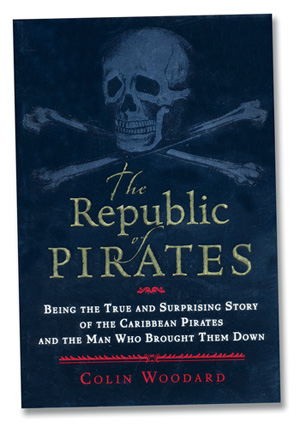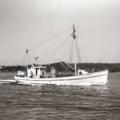Review - The Republic of Pirates
The Real Pirates of the Caribbean
By Janet Mendelsohn


The Republic of Pirates:Being the True and Surprising Story of the Caribbean Pirates and the Man Who Brought Them Down
By Colin Woodard
Harcourt (2007); 383 pages;
hard cover, $27.
You may share traits with pirates of yore. Apparently I do. There’s our affinity for the water, of course, secluded Caribbean coves and a tendency to lust after faster, better-equipped vessels than our own. Impatience with unearned authority is another, as is an aversion to shady politicians and anyone who attempts to curtail our independence. Perhaps comparisons end there, but as The Republic of Pirates, by Colin Woodard, reveals, eighteenth-century pirates created their own kind of democracy in an effort to better their lives.
Woodard, a Portland-based journalist, is the author of The Lobster Coast and Ocean’s End. This time he gives us a meticulously researched history of the Golden Age of Piracy, from 1715 to 1725, when events contrived to turn merchants and mariners, deserters, gentlemen, runaway slaves, and a few cross-dressing women, into rebels of the sea. Written primarily from the Caribbean pirates’ point of view, it puts their motivations into perspective. They were fed up with their oppressors—brutal captains and ship owners, navy commanders and owners of slave plantations. From their “pirate paradise” in Nassau, Bahamas, the pirates commanded what Woodward describes as “a zone of freedom in the midst of an authoritarian age.” Their maritime revolt shook the British Empire, brought transatlantic commerce to a halt, and fueled “democratic sentiments that would lead into the American revolution.”
Primarily English and Irish, but Scottish, French, Swedish, and Native American as well, the Caribbean pirates formed a common culture, frequently casting aside traditional enemies to come to each others’ aid. Two or three dozen pirate commodores knew each other well, having served together in the past, on merchant or pirate vessels.
Captains were voted in by their crew and ruled with an iron hand. They were voted out when the electorate lost confidence in their command. Plunder was shared equally and important decisions were determined in open council. African slaves were treated as cargo but, when captured, sometimes became pirates who were treated as equals. Only in the republic of pirates did ordinary sailors have rights.
“Unlike their pirate predecessors, they were engaged in more than simple crime and undertook nothing less than a social and political revolt,” writes Woodard. In their own era, they became folk heroes whose sympathizers included traders and Bahamian governors who secretly caroused with the rebels and supplied them with guns, ammunition, and provisions.
According to Woodard, British authorities estimated the worldwide pirate population at about 2,000 during its peak (1716 to 1718). Chief among their opponents was an English merchant fleet owner, Woodes Rogers, a British loyalist appointed governor of the Bahamas by King George. Rogers staked his name on the capture of a fellow native of Bristol, Edward “Blackbeard” Thatch, who, at one point commanded 700 pirates. Despite Rogers’s victories against many other pirates, news of his success failed to reach London fast enough. He was removed from office and returned to England, where he was an outcast and destitute until a tremendously popular book of the time turned him into a national hero. That book, A General History of the Robberies and Murders of the Most Notorious Pyrates (still in print), by an anonymous author, captivated the English-speaking world. Its insights and stories provided rich material for Woodard.
By 1725, only about 200 pirates remained active although piracy has never been eliminated, as mariners well know. [In 2000, more than 450 incidents against shipping world-wide were reported to the International Maritime Organization, dropping to just under 250 incidents reported in 2006.]
“Calico Jack” Rackham and his cross-dressing lover, Anne Bonny; Benjamin Hornigold, who founded the “pirate republic;” Stede Bonnet, a gentleman turned pirate; and many others actually hoisted the “jolly roger,” the familiar black flag with white death mask. With varying degrees of accuracy, they and their exploits live on in fiction and film as Captain Hook, Long John Silver, and Jack Sparrow.
Real pirate Edward “Black Sam” Bellamy, like many, fell into piracy out of desperation. When the War of the Spanish Succession ended in 1713, thousands of sailors suddenly were unemployed; the Royal Navy was bankrupt; and merchant captains cut wages in half as every port overflowed with men hungry for work. In 1714, Bellamy was a penniless sailor with family connections on Cape Cod where he became a business partner with Paulsgrave Williams, a wealthy, well-connected silversmith. They were a devious and successful team. They left New England for the Caribbean, where Bellamy swiftly rose to leadership. Within a year, he was commodore of 170 pirates and captain of Whydah, an 18-gun merchant ship that he and his crew had captured in Jamaica.
For two years, Whydah’s crew wreaked havoc in the Leeward Islands, then gradually worked their way north. Following a lucrative spring pirating season in the East Coast shipping lanes, Bellamy planned to end up in Maine, where uninhabited coastline, countless anchorages hidden from the Europeans, and a shoreline covered in pine forest would have made an ideal pirate’s retreat. But on April 26, 1717, Whydah was wrecked in a northeaster off Wellfleet Beach, Cape Cod, with 140 pirates aboard.
Woodard describes the event:
“The Whydah ran aground with shocking force. The jolt likely shot any men in the rigging out into the deadly surf, where they were alternately pounded against the sea bottom, then sucked back away from the beach by the undertow. Cannon broke free from their tackles and careened across the lower decks, crushing everyone in their path. One pirate was thrown across the deck so hard his shoulder bone became completely embedded in the handle of a pewter teapot. Little John King, the nine-year-old pirate volunteer, was crushed between decks, still wearing the silk stockings and expensive leather shoes his mother had dressed him in aboard the Bonetta months earlier. Within fifteen minutes, the violent motion of the surf brought the Whydah’s mainmast crashing down over the side. Waves broke over the decks and water poured into the bedlam of crashing cannon and barrels of cargo below decks. At dawn the Whydah’s hull broke apart, casting both the living and the dead into the surf.”
Bellamy was the first of the legendary pirates to die; Whydah still lies where it was wrecked, and is considered to be the only verified pirate shipwreck. Survivors told authorities a brief stop on Cape Cod to resupply the ship had been planned. But, reports Woodard, local legend claims Bellamy’s real goal was to reunite with the love he’d left behind and impress her family with his career success.
Whether or not Bellamy’s judgment was clouded as storm conditions brewed, his actions differed little from those of his fellow pirates of the Caribbean. Bloodthirsty or benevolent, we learn that they were driven by dreams and human frailty as they tried to better their lives. When British authorities finally regained control of Bahamian waters, only a few hundred pirates remained. Their Golden Age ended: some returned to traditional seafaring, others shifted their piracy elsewhere, and a few retired in comfort.
















